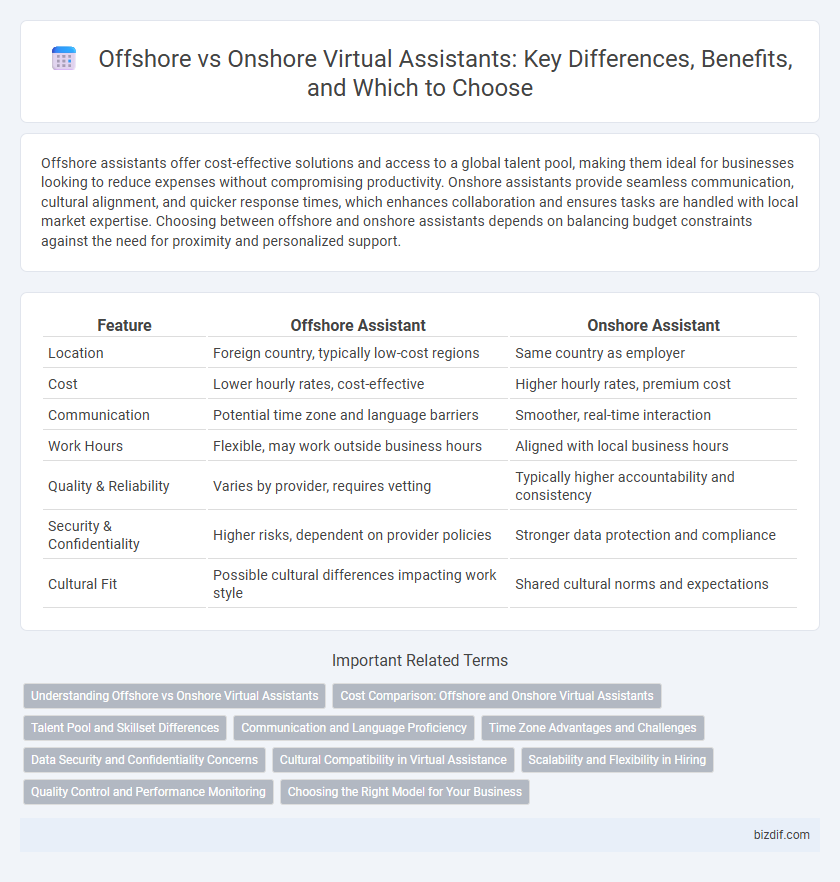Offshore assistants offer cost-effective solutions and access to a global talent pool, making them ideal for businesses looking to reduce expenses without compromising productivity. Onshore assistants provide seamless communication, cultural alignment, and quicker response times, which enhances collaboration and ensures tasks are handled with local market expertise. Choosing between offshore and onshore assistants depends on balancing budget constraints against the need for proximity and personalized support.
Table of Comparison
| Feature | Offshore Assistant | Onshore Assistant |
|---|---|---|
| Location | Foreign country, typically low-cost regions | Same country as employer |
| Cost | Lower hourly rates, cost-effective | Higher hourly rates, premium cost |
| Communication | Potential time zone and language barriers | Smoother, real-time interaction |
| Work Hours | Flexible, may work outside business hours | Aligned with local business hours |
| Quality & Reliability | Varies by provider, requires vetting | Typically higher accountability and consistency |
| Security & Confidentiality | Higher risks, dependent on provider policies | Stronger data protection and compliance |
| Cultural Fit | Possible cultural differences impacting work style | Shared cultural norms and expectations |
Understanding Offshore vs Onshore Virtual Assistants
Offshore virtual assistants typically offer cost-effective solutions by operating from countries with lower labor costs, providing businesses access to skilled professionals across various time zones. Onshore virtual assistants work within the same country as the client, ensuring easier communication, cultural alignment, and faster turnaround times. Choosing between offshore and onshore virtual assistants depends on priorities such as budget, communication preferences, and project complexity.
Cost Comparison: Offshore and Onshore Virtual Assistants
Offshore virtual assistants typically offer significantly lower hourly rates, often ranging from $5 to $15, compared to onshore assistants whose rates can span $25 to $50 or more, reflecting differences in living costs and economic conditions. Cost savings from offshore virtual assistants include reduced overhead expenses, while onshore assistants may provide advantages in time zone alignment and cultural understanding, justifying higher fees. Businesses must weigh budget constraints against communication preferences and project requirements when deciding between offshore and onshore virtual assistance.
Talent Pool and Skillset Differences
Offshore assistants typically offer access to a larger, cost-effective talent pool with diverse technical skills, including expertise in IT, customer support, and multilingual capabilities. Onshore assistants tend to have a narrower talent pool but provide higher proficiency in local market knowledge, cultural nuances, and advanced communication skills. Skillset differences often reflect the geographic focus, with offshore assistants excelling in scalable operational tasks and onshore assistants specializing in client-facing, time-sensitive, and complex problem-solving roles.
Communication and Language Proficiency
Offshore assistants often offer cost-effective solutions but may face challenges with language nuances and real-time communication due to time zone differences. Onshore assistants provide superior communication clarity and immediate interaction, ensuring accurate understanding and quick response times. Language proficiency and cultural alignment with onshore assistants enhance the effectiveness of customer interactions and task execution.
Time Zone Advantages and Challenges
Offshore virtual assistants offer the advantage of round-the-clock support due to complementary time zones, enabling continuous business operations and faster turnaround times. However, challenges include coordinating meetings and real-time communication delays caused by significant time differences. Onshore assistants provide synchronous availability and easier collaboration within the same time zone, though this can lead to limited coverage outside standard business hours.
Data Security and Confidentiality Concerns
Offshore virtual assistants often pose increased data security and confidentiality risks due to differing international data protection laws and potential vulnerabilities in cross-border data transfers. Onshore assistants operate under stricter local regulations like GDPR or CCPA, ensuring enhanced compliance and better control over sensitive information. Companies prioritizing data security frequently prefer onshore assistants to mitigate risks associated with offshore data breaches and unauthorized access.
Cultural Compatibility in Virtual Assistance
Cultural compatibility in virtual assistance significantly influences communication efficiency and project outcomes, with onshore assistants typically offering deeper cultural alignment and nuanced understanding of local business practices. Offshore assistants may require more extensive cultural training to bridge potential gaps in work style, language nuances, and time zone coordination. Selecting virtual assistants based on cultural fit enhances teamwork, reduces misunderstandings, and fosters a seamless collaboration experience.
Scalability and Flexibility in Hiring
Offshore assistants offer greater scalability by providing access to a larger global talent pool, enabling businesses to quickly adjust workforce size based on demand fluctuations. Onshore assistants deliver enhanced flexibility in hiring with easier communication, cultural alignment, and instant availability for urgent tasks. Combining offshore for cost-effective scaling and onshore for specialized, immediate support optimizes operational efficiency and resource allocation.
Quality Control and Performance Monitoring
Offshore assistants often require rigorous quality control frameworks and frequent performance monitoring due to potential communication barriers and time zone differences affecting task accuracy. Onshore assistants benefit from closer supervision and real-time feedback loops, enabling higher consistency in meeting quality standards and swift performance adjustments. Implementing standardized metrics and regular performance audits is crucial for maintaining productivity and service excellence in both offshore and onshore virtual assistant models.
Choosing the Right Model for Your Business
Choosing between offshore and onshore virtual assistants depends on factors such as cost efficiency, communication preferences, and time zone alignment. Offshore assistants often provide significant cost savings and access to a global talent pool, while onshore assistants offer easier real-time collaboration and cultural alignment. Businesses must evaluate workload complexity, budget constraints, and integration needs to select the optimal virtual assistant model.
Offshore assistant vs Onshore assistant Infographic

 bizdif.com
bizdif.com